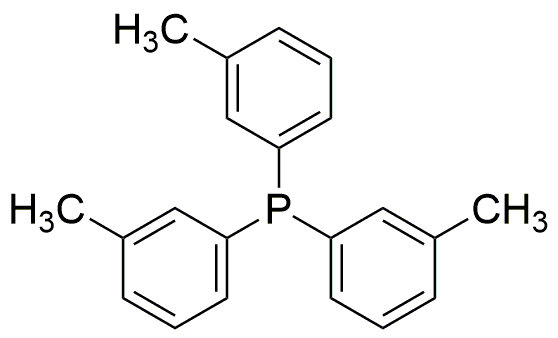Tri(m-tolyl)phosphine is widely utilized in research focused on:
- Catalysis: This compound serves as an effective ligand in various catalytic processes, particularly in transition metal catalysis, enhancing reaction rates and selectivity in organic synthesis.
- Organic Synthesis: It plays a crucial role in the synthesis of complex organic molecules, including pharmaceuticals and agrochemicals, by facilitating key reactions such as cross-coupling.
- Material Science: Tri(m-tolyl)phosphine is used in the development of advanced materials, including polymers and nanomaterials, due to its ability to stabilize metal nanoparticles.
- Pharmaceutical Development: In medicinal chemistry, it aids in the design of new drug candidates by serving as a building block in the synthesis of bioactive compounds.
- Research and Development: This compound is valuable in academic and industrial research settings for exploring new chemical reactions and developing innovative methodologies.
General Information
Properties
Safety and Regulations
Applications
Tri(m-tolyl)phosphine is widely utilized in research focused on:
- Catalysis: This compound serves as an effective ligand in various catalytic processes, particularly in transition metal catalysis, enhancing reaction rates and selectivity in organic synthesis.
- Organic Synthesis: It plays a crucial role in the synthesis of complex organic molecules, including pharmaceuticals and agrochemicals, by facilitating key reactions such as cross-coupling.
- Material Science: Tri(m-tolyl)phosphine is used in the development of advanced materials, including polymers and nanomaterials, due to its ability to stabilize metal nanoparticles.
- Pharmaceutical Development: In medicinal chemistry, it aids in the design of new drug candidates by serving as a building block in the synthesis of bioactive compounds.
- Research and Development: This compound is valuable in academic and industrial research settings for exploring new chemical reactions and developing innovative methodologies.
Documents
Safety Data Sheets (SDS)
The SDS provides comprehensive safety information on handling, storage, and disposal of the product.
Product Specification (PS)
The PS provides a comprehensive breakdown of the product’s properties, including chemical composition, physical state, purity, and storage requirements. It also details acceptable quality ranges and the product's intended applications.
Certificates of Analysis (COA)
Search for Certificates of Analysis (COA) by entering the products Lot Number. Lot and Batch Numbers can be found on a product’s label following the words ‘Lot’ or ‘Batch’.
Numéro de catalogue
Numéro de lot/série
Certificates Of Origin (COO)
This COO confirms the country where the product was manufactured, and also details the materials and components used in it and whether it is derived from natural, synthetic, or other specific sources. This certificate may be required for customs, trade, and regulatory compliance.
Numéro de catalogue
Numéro de lot/série
Safety Data Sheets (SDS)
The SDS provides comprehensive safety information on handling, storage, and disposal of the product.
DownloadProduct Specification (PS)
The PS provides a comprehensive breakdown of the product’s properties, including chemical composition, physical state, purity, and storage requirements. It also details acceptable quality ranges and the product's intended applications.
DownloadCertificates of Analysis (COA)
Search for Certificates of Analysis (COA) by entering the products Lot Number. Lot and Batch Numbers can be found on a product’s label following the words ‘Lot’ or ‘Batch’.
Numéro de catalogue
Numéro de lot/série
Certificates Of Origin (COO)
This COO confirms the country where the product was manufactured, and also details the materials and components used in it and whether it is derived from natural, synthetic, or other specific sources. This certificate may be required for customs, trade, and regulatory compliance.


